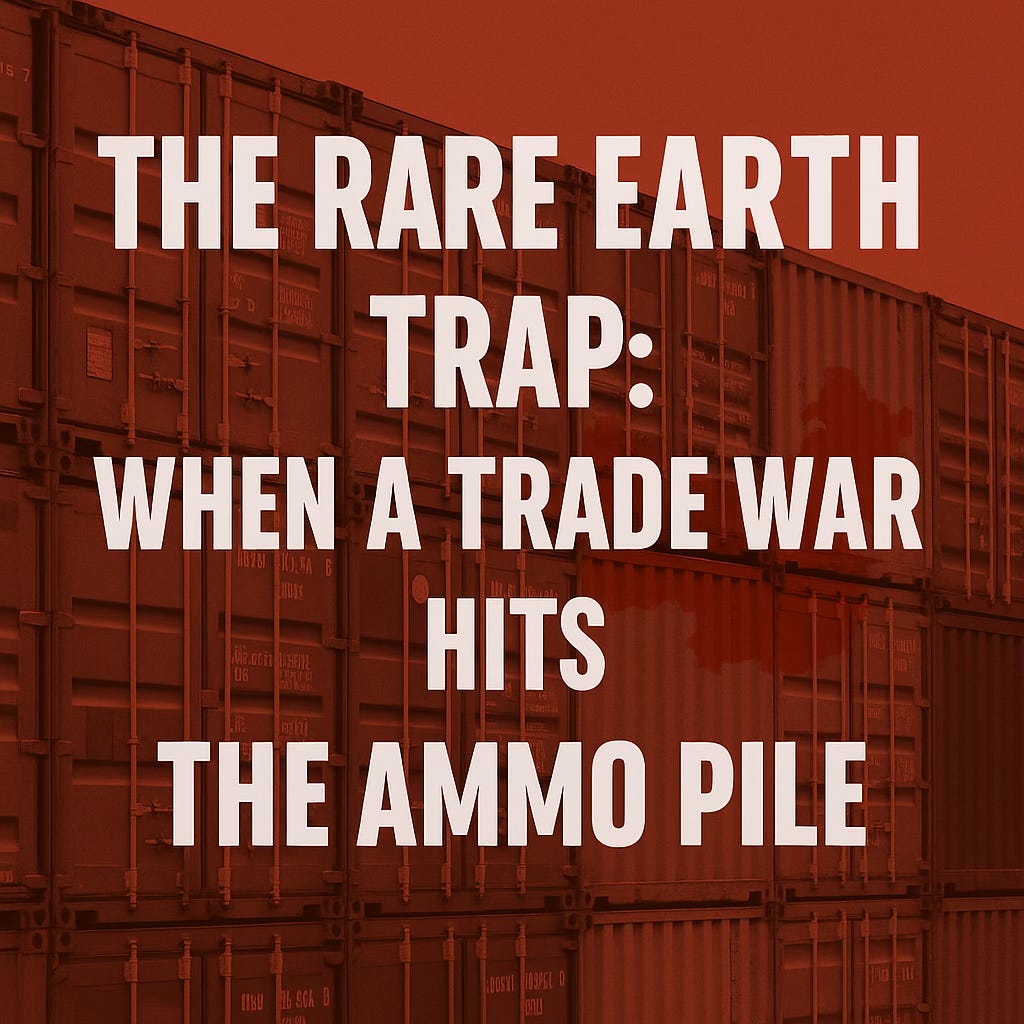The Rare Earth Trap: When a Trade War Hits the Ammo Pile
The thing about picking a fight is knowing what you’re fighting with. And what you’re risking.
🧭 The Gist:
Trump’s trade war with China wasn’t just about tariffs — it exposed a critical weakness in our national defense. China responded by choking off rare earth exports, the minerals we need to build jets, missiles, and advanced weapons systems. The Pentagon saw this coming years ago. Trump didn’t. Now we’re scrambling to catch up — and the consequences could be felt where it matters most: on the battlefield.
Back in January, Trump came out swinging with a fresh round of tariffs on Chinese goods. All of them. His team called it a “reset.” China called it what it was — a chance to hit back where it hurts. Not with tweets or threats, but with leverage. And they’ve got plenty of it in the ground.
China controls nearly all of the world’s rare earth elements — the metals you don’t think about but that keep everything in our defense arsenal running. Think:
F-35 fighter jets
Submarines
Drones
Radar systems
Guided missiles
These aren’t luxury goods. These are mission-critical.
🔒 What China Just Did
In April, China stopped exporting certain rare earth materials — unless you manufacture your product inside China. For U.S. defense contractors? That’s a hard no. If your company is even remotely connected to the Pentagon, you’re either being denied or slow-walked through a new licensing system designed to grind you down.
This isn’t new behavior — they tried it with Japan back in 2010 — but this time, they’re playing it smarter. The U.S. started a trade war without securing the one thing we can’t build bombs, planes, or guidance systems without.
Ask any logistics NCO — you don’t wait until the bullets stop coming to ask where the next crate is.
🧨 Strategic Genius? Or Strategic Faceplant?
Here’s the thing — Trump might’ve seen this coming if he’d ever considered the possibility that he didn’t know everything. The Pentagon had been sounding the alarm about our rare earth dependence for over a decade. He ignored it. Burned the clock. Then charged into a trade war blind, with our supply chain exposed and no plan to back it up.
🏗️ The U.S. Response? Playing Catch-Up
The government is finally throwing money at the problem:
• Contracts to domestic mining companies
• Fast-tracking new magnet manufacturing facilities
• Partnering with allies like Japan and Australia to build out new supply chains
All good — but too slow. Most of this won’t come online until 2026 or later. That’s a long time to hope nothing serious pops off.
⚖️ Strategic Thinking: FDR vs. Trump
Let’s compare two very different models of leadership.
🧠 FDR’s Proactive Strategy — Rubber Before It Was Too Late
Long before the U.S. entered WWII, FDR treated rubber like what it was: a strategic lifeline. Japan controlled most natural rubber, and FDR knew a war without it wasn’t winnable. So in 1939, the U.S. passed the Strategic and Critical Materials Stockpiling Act. Then he greenlit massive investments in synthetic rubber, stood up entire factories, and rationed gasoline to stretch the rubber we had. By 1942, the U.S. wasn’t just surviving — it was outproducing the Axis powers on rubber, thanks to early planning.
FDR didn’t wait for the crisis. He beat it to the punch.
📉 Trump’s Reactive Misstep — Tariffs Without a Backup
Now jump to 2025. Trump restarts a trade war with China—without securing our rare earth supply chain first. China hits back with rare earth restrictions in April, and suddenly our F-35s, submarines, and guided missile systems are caught in the crossfire. The Pentagon had been warning about this risk for years. He didn’t listen.
Result? We’re stuck waiting on new mines to open, plants to be built, and supply chains to be rewired—while China holds the keys.
🧾 Bottom Line
This trade war wasn’t just about tariffs. It triggered something bigger — a supply chain chokehold. And in doing so, it forced a hard look at just how unprepared we are to fight without foreign parts.
This isn’t just a trade war — it’s a supply chain war. And we’re late to the battlefield.
We didn’t just back ourselves into a corner. We left the ammo pile unguarded.
You don’t need to win the trade war to win the fight. But you damn well need to be able to make your own weapons.
We’re not there yet. But we better be soon.
✅ Takeaway
For veterans, defense workers, and policymakers:
• We’re still too dependent on China for the materials our defense systems need.
• Until domestic supply chains are fully online, China holds leverage over our weapons production.
• The next National Defense Authorization Act needs more than funding—it needs foresight.
• Start treating materials like ammo. Because they are.



